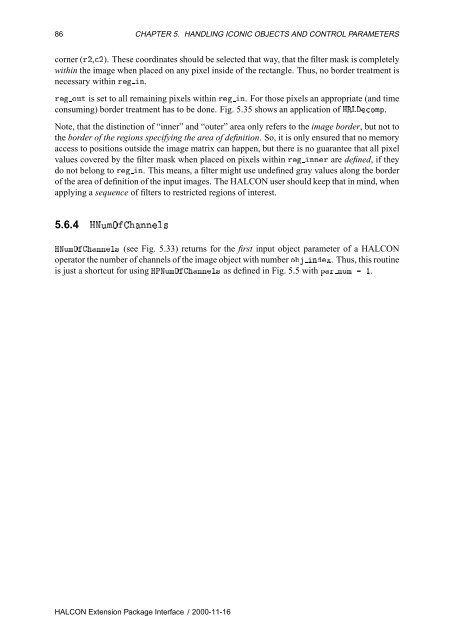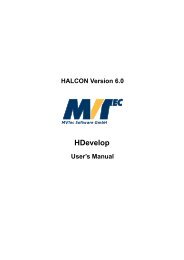HALCON Extension Package Programmer's Manual
HALCON Extension Package Programmer's Manual
HALCON Extension Package Programmer's Manual
- No tags were found...
You also want an ePaper? Increase the reach of your titles
YUMPU automatically turns print PDFs into web optimized ePapers that Google loves.
86 CHAPTER 5. HANDLING ICONIC OBJECTS AND CONTROL PARAMETERScorner (Ö¾,¾). These coordinates should be selected that way, that the filter mask is completelywithin the image when placed on any pixel inside of the rectangle. Thus, no border treatment isnecessary within Ö Ò.Ö ÓÙØ is set to all remaining pixels within Ö Ò. For those pixels an appropriate (and timeconsuming) border treatment has to be done. Fig. 5.35 shows an application of ÀÊÄÓÑÔ.Note, that the distinction of “inner” and “outer” area only refers to the image border, but not tothe border of the regions specifying the area of definition. So, it is only ensured that no memoryaccess to positions outside the image matrix can happen, but there is no guarantee that all pixelvalues covered by the filter mask when placed on pixels within Ö ÒÒÖ are defined, iftheydo not belong to Ö Ò. This means, a filter might use undefined gray values along the borderof the area of definition of the input images. The <strong>HALCON</strong> user should keep that in mind, whenapplying a sequence of filters to restricted regions of interest.5.6.4 ÀÆÙÑÇÒÒÐ×ÀÆÙÑÇÒÒÐ× (see Fig. 5.33) returns for the first input object parameter of a <strong>HALCON</strong>operator the number of channels of the image object with number Ó ÒÜ. Thus, this routineis just a shortcut for using ÀÈÆÙÑÇÒÒÐ× as defined in Fig. 5.5 with ÔÖ ÒÙÑ ½.<strong>HALCON</strong> <strong>Extension</strong> <strong>Package</strong> Interface / 2000-11-16
















